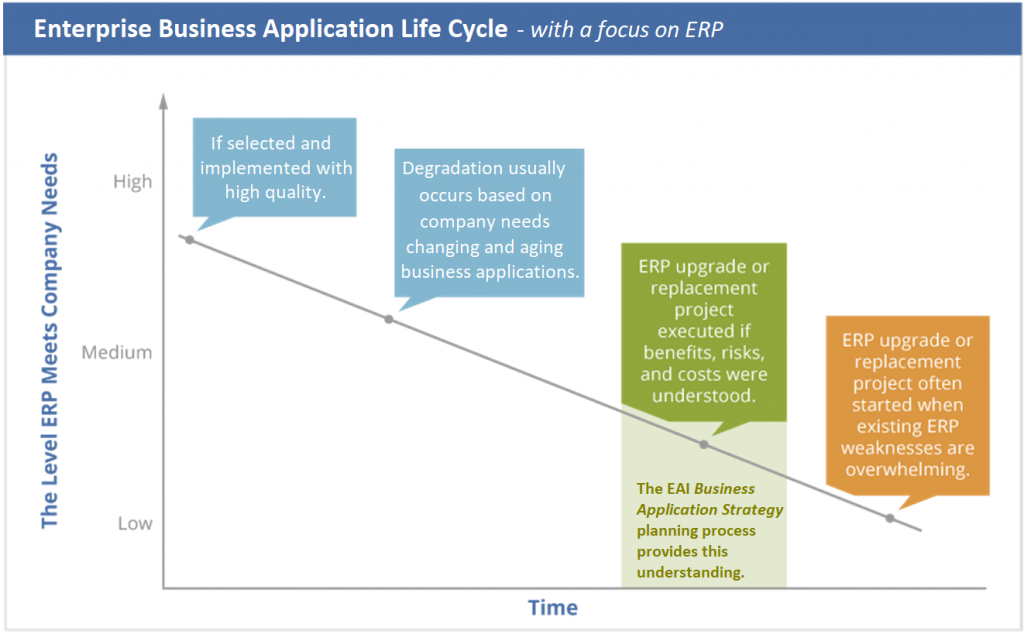Developing an Enterprise Business Application Strategy
The Problem and Opportunity
At most companies, operations management would admit that business application usage and integration of enterprise business processes could be significantly improved. An informed Enterprise Business Application Strategy is based on understanding answers to the following questions:
- Can existing ERP software be improved or upgraded to meet current and projected needs? And for how long?
- Are there enough deficiencies in current ERP functionality, technology, or vendor status to justify searching for new ERP software?
- What is the proper role for other existing or potential new business applications?
- Who should be responsible for business applications, department coordination, and change management?
Without the guidance of a well-crafted Enterprise Business Application Strategy plan, companies tend to delay fixing business application deficiencies and in many cases are not aware of improvement opportunities. Further, most business application projects are not well-planned or executed. Over time this results in a business application environment that’s unnecessarily difficult and expensive to maintain, and falls well short of the potential of well-implemented modern business applications. Having such an Enterprise Business Application Strategy plan is especially important as companies enter the green zone in the chart below.

Developing this Important Plan
Engleman Associates, Inc. offers a process to develop a realistic and defensible Enterprise Business Application Strategy plan. Our approach and skill is based on more than 1000 ERP software projects conducted since 1996.
The Enterprise Business Application Strategy plan is designed to improve confidence on whether a company should improve existing ERP or implement new ERP, and when—for the greatest benefit to the company. The plan also contemplates major satellite business applications that integrate with ERP, or may replace specific ERP functionality; hence the name 'Enterprise' Business Application Strategy planning. This service offering is configured for a specific client's situation.
The Enterprise Software Strategy Planning Process
- Project Set-up Planning and Confirm/Prepare the Company Team: This includes relevant education for company team members on current-market ERP, Cloud ERP risks and benefits, techniques to comprehensively control ERP software project costs and risks, and more.
- Enterprise Discovery Collection: Includes the following for affected business process areas and business units:
- Big Picture: Discovery about the company from a big-picture or strategic level. Discussions take place in both groups and/or individual executive/stakeholder interviews as appropriate.
- Discovery - High-level for affected business process areas and Business Units: The business process area or business unit interview techniques are built to detect weaknesses and potential business processes opportunities related to ERP and satellite business systems.
- Discovery - Enterprise business application options and IT infrastructure status: This discovery seeks details about strengths and weaknesses of ERP options, satellite business applications, and overall IT infrastructure that supports business applications.
- Enterprise Discovery Build-out and Stabilization: Further develop and organize all company findings for potential use in the development of the Enterprise Business Application Strategy plan.
This includes findings from the big-picture/strategic interviews, business process interviews, business application/IT infrastructure discussions and other findings. The results should be placed into a unified Enterprise Discovery structure to make the background information easily usable in future business application projects. - Strategic Goals: Confirm, develop, and unify business strategic goals for use in influencing the Enterprise Business Application Strategy plan. These goals could also be categorized as enterprise goals for which many business process areas are involved to make progress toward achieving them.
- Enterprise Business Application Strategy: Develop Enterprise Business Application Strategy plan components and initial Enterprise Business Application Strategy Report. The typical components are:
- Key Improvement Opportunities - functional, strategic, and IT/application infrastructure.
- ERP Boundary Diagram(s) - Showing what business processes new or improved ERP and other major business application are projected to support.
- Validate the Potential ERP Improvement Options - Test the strength of contemplated options.
- Cost, Risk, and Benefits - For potential ERP and other major business application improvement options as compared to current status.
- Enterprise Business Application Strategy Recommendations - Summary of key findings.
- Executing the Enterprise Business Application Strategy - Key success factors underscored by experience of EAI's 1000 plus ERP projects.
- Enterprise Business Application Strategy Plan Validation Workshop: This workshop is intended to 1) confirm that the Enterprise Business Application Strategy is meeting expectations, and 2) tune how it should be communicated to the larger company team that needs to approve the plan and be involved in executing it going forward. This workshop is intended to include the key company project members, other selected company team members, and one or more external experts presumed to have led the planning up to this point.
- Final Enterprise Business Application Strategy Report developed and debriefed: The report includes the components listed above in Step #5, with the bulk of the findings in various addendums, referenced documents, or other sources. The final report is debriefed to the company team members.



